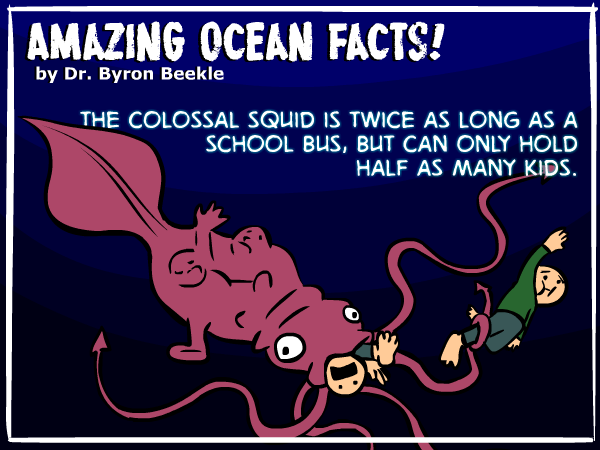

For those of you who may not know, our blue marble is called “the blue marble” because the planet is covered in roughly 70% water. Unsurprisingly, humans (habitual land dwellers) often view the ocean with suspicion–it is a strange and alien place. In fact, many biologists and oceanographers assert that we know more about the moon and the inner solar system than we do Earth’s oceans (at least at the deepest depths). Since we have evolved to live on land, many people have a deep-rooted fear of the sea…of what lurks just beyond the edge of their favorite beaches and swimming holes.
As it turns out, the fictions aren’t too far from the facts. Take, for example, the colossal squid. Although we have technically known about them for centuries, until very recently, these tales were disbelieved and considered fictitious because the squid were never photographed, neither had they ever been found washed-up on beaches; however, in recent times, these creatures actually started washing up on shores around the world (parts of them, anyways), and some have even been recorded on video.
The squid ultimately go by two distinct scientific names Architeuthis and the Mesonychoteuthis: or the giant and colossal squid (respectively). These two species traverse the waters between the deep sea and the shallows, allowing them to enjoy a wider range of food. Because they have access to so much food, they grow to epic proportions.
The Giant Squid:

The giant squids (Architeuthis) typically weigh around 200 kg (440 lbs) and reach enormous lengths. Recent estimates put the maximum size at 13 m (43 ft) for females and 10 m (33 ft) for males, or the size of a school bus. They have 8 arms and 2 longer tentacles. Each of these is lined with hundreds of sucker cups, which happen to be lined with finely serrated chitin (think: tiny, razor sharp knives). These have the tendency to leave nasty scars on anything they touch, especially around the heads of their main predators, the sperm whale. Fortunately, the squid are extremely agile, using a kind of jet propulsion to quickly evade the massive sperm whales, and like all cephalopods, they can disperse dense clouds of black ink to escape.
And they are more than just large. They are fast, strong, and smart.
The giant squid has a sophisticated nervous system and complex brain, attracting great interest from scientists. It also has the largest eyes of any living creature, except its bigger relative, the colossal squid. These eyes can be up to at least 27 cm (11 in) in diameter, with a 9 cm (3.5 in) pupil. These large eyes can better detect light, which is scarce in deep water. This is important as the squid are attracted to bioluminescent fish in order to feed. Typically, the squid are attracted to the lights of jellyfish; however, this is not to eat the jellyfish itself (as they would not make much of a meal for these huge creatures). Instead, the squid attack and eat the large creatures trying to eat the jellyfish. In some cases, scientists assert that the bioluminescence acts as a distress call from the jellyfish, a last ditch effort to attract an even larger predator (the squid) to eat what is trying to eat it.
WATCH: The Giant Squid

The Colossal Squid:
Mesonychoteuthis, or the colossal squid, is even bigger than Architeuthis. This denizen of the deep is one of the largest living organisms on the globe. It is certainly is the largest known invertebrate. Current estimates put its maximum size at 12–14 m (39–46 ft), and it is also the largest squid by mass. It sometimes goes by the name of Antarctic or Giant Cranch squid, but little is known of it besides a few dead specimens (mostly, they are already partially eaten). It differentiates from the giant squid by having a much larger and longer mantle (body) and smaller tentacles.

Its eyes are slightly bigger (the biggest in the animal kingdom at 12 inches in diameter). Because of its location in the cold waters in Antarctica, and also because of its larger mass, this squid ambushes instead of hunts. This makes sense, as it would take a lot of energy for the squid to roam about looking for food.
One primary (and sinister) difference between these two abyssal behemoths is their weaponry. The colossal squids arms, unlike the giant squid’s arms and tentacles (which only have suckers lined with small chitin teeth), are equipped with large, sharp hooks that actually swivel. These beasts also have other hooks that are shaped like three-pointed daggers.
The ocean deep still harbors fear-inspiring monsters. Luckily, human interaction with them is few and far between. As scary they are, they are incredibly fascinating, and make us wonder what else could be lurking in the cold dark depths. Scientists still have a lot to learn about these creatures, and still have many more secrets to unlock on our beautiful planet Earth.